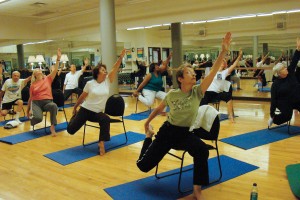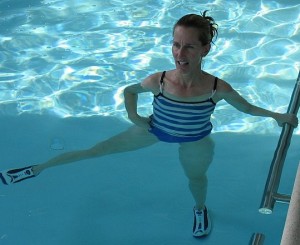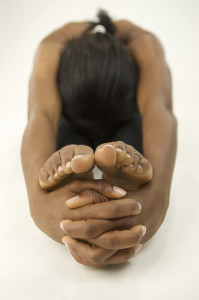by Michelle Sutton-Kerchner
May’s warm weather often soothes aches and pains. We tend to forget joint and bone health as we plow along in gardens, ball games, and spring cleaning. It’s the perfect time for Arthritis Awareness Month. A reminder to care for your body’s structure, even when it isn’t crying for attention …
The Reality
Arthritis consists of more than 100 different conditions that affect people of all ages, races, and backgrounds. Over 50 million Americans have arthritis; two-thirds of them are under age 65. Children are not immune, with 300,000 suffering from juvenile arthritis.
As the leading cause of disability in the United States, arthritis accounts for 44 million outpatient visits and 992,100 hospitalizations every year. Although arthritis itself is not fatal like some diseases, it can severely diminish quality-of-life with its mobility-limiting pain and discomfort.
How do these facts relate to your springtime? They are a reminder to strengthen the structure in which you reside. Care for your bones and joints today and they’ll be prime real estate for your retirement body. Aches are not a natural part of aging. Be proactive.
Move Properly
Throughout the day, we lift, pull, push, and bend over backwards to get things accomplished. Be mindful of your movements and the stress they place on the skeletal and muscular systems. A personal trainer can demonstrate proper ways to lift weights, execute exercises, and perform everyday tasks.
Injuries often are a result of rushing. Take the extra few minutes to carry smaller loads, wear supportive shoes, and assure fluid movement. Prior to strenuous activity, several deep breaths deliver oxygen throughout the body and relieve stress. Simple cleansing breaths can be the difference between a spring in your step and a pulled neck.
Warm Up & Cool Down

Veteran exercisers know the importance of a good warm-up and cool-down. Unfortunately, some have learned the hard way. One member admits she suffers from her youth’s false sense of invincibility. She tells of never warming up and stretching during her younger years. She hit the ground running , literally. Today, she still runs, but her knees won’t let her forget missteps of earlier years.
Elevate your heart rate gradually. Once warm, spend five to 10 minutes on a full-body stretch session. Cool down the same way. Slowly decrease your heart rate, and flow your body into a stretch session. Think of it as an art form. Out with the jarring movements. Go with the flow.
Exercise
Exercise is essential in maintaining healthy joints and preventing arthritis. For those already diagnosed with arthritis, exercise can reduce pain and increase range-of-motion (ROM). It also helps by decreasing inflammation throughout the body; strengthening muscles, which cushion joints; increasing bone strength; maintaining a healthy weight; and improving energy level.
Accomplish a well-rounded workout. A fitness program should include strength training, aerobic exercises, and ROM exercises to loosen any stiff joints. According to the U.S. Department of Health and Human Services, there is strong evidence indicating endurance and resistance exercises provide considerable disease-specific benefits for people with osteoarthritis and rheumatic conditions.

If you already suffer from arthritis– or a sloppy maneuver on the basketball court — consider water workouts. Warm water soothes aches and the buoyancy reduces strain on joints and bones. The Center’s extensive aquatic offerings include therapeutic programs. Surrounded by water, the body is relieved of stiffness. The entire skeleton is supported. Arthritic swimmers can more easily move their joints through full ROM. While treating symptoms in the comfort of water, you simultaneously strengthen to help heal the cause.
A personal trainer can create an exercise program that recognizes any current limitations and works toward overcoming them. With the Center’s nurse assessment and your health history, members predisposed to arthritis in any form can take preventative action. Some personal trainers are specialized in this area, and all are qualified to customize a fitness program to meet specific needs. (Yes, that includes a plan to help loosen that shoulder impingement affecting your golf game.)
The rise in arthritis is often linked to the increase in overweight and obese individuals. Some experts blame obesity for the increased early-onset of arthritis in today’s younger population. Obesity is a major risk factor for arthritis of weight-bearing joints, such as the knees and hips. Those with arthritis exacerbate their condition if they are overweight, which can intensify symptoms and increase progression. Once again, exercise is part of the solution.
Fact: One lost pound of body weight takes four pounds of pressure off each knee.
Fact: Experts believe a loss of only 11 pounds can reduce the development of new knee osteoarthritis for some people.
Reducing your risk may only require a few less pounds. You’ve got this!
Your complimentary nurse assessment can help determine your ideal body weight. If you have a ways to go, know your knees will be happier with each pound shed.
The Random Pop and Crack
That sweet relief delivered by a nice twist of the torso or roll of the neck and shoulders. The body responds with a crack and you sigh happily. These folks should be happy to know bone cracking is not linked to arthritis.

The cracking produced when bones and joints are manipulated is caused by a change in pressure of the synovial fluid in a joint. All synovial joints are surrounded by a joint capsule filled with fluid. This fluid lubricates the joints and minimizes friction.
If a joint is immobile long enough, some of the fluid between the bones seeps out and a temporary vacuum, or fixation, occurs. Natural pockets of gas within the joint form a bubble and quickly collapse causing the sound. This explains the cracking we hear upon waking in the morning during a good stretch. It takes approximately 20 minutes for the gas to reabsorb before you can “pop” the same area again.
Cracking and popping can be triggered purposefully through chiropractic or self-manipulation. Although it may sound, well, crunchy and disconcerting, many find it a welcome relief. The process stimulates Type III joint mechanoreceptors, which causes relaxation of muscles around the joint. Suddenly, the previously tense area feels loose and relaxed. Experts also speculate natural painkillers are released after cracking. This feel-good response can become addictive, and explains those who habitually crack or see a specialist for such “realignment.”
During chiropractic treatment, you’ll often hear cracking or popping as your joint is manipulated. The goal is to relieve pain and improve body functioning, mainly through adjusting the nerves surrounding the spinal cord. Methodically applying force to a joint through hand pressure, the chiropractor can push beyond the normal ROM, causing a cracking sound. A chiropractor is a professional. You should not try to replicate this response at home.
The Noisy Workout
Do you move to a beat of your own clicking and cracking?
Bone cracking also can occur without prompting, such as during exercise or when changing positions. It is common for clicks and noises to happen during a workout. This can change daily as your body becomes familiar and adjusts to the routine. Changes in muscle strength and flexibility affect the chorus of sounds delivered.

Monitor if and how your workout impacts cracking of joints over time. Discuss it with a personal trainer or at your nurse assessment. Usually, if pain does not accompany the sound, harm is not being done. If popping is frequent, a trainer can help make easy adjustments to your movement that may prevent this.
Repetitive clicks could indicate misalignment of connective tissue, which also shifts with physical activity such as exercise or simply walking or climbing stairs. At some point, we all have ascended the stairs to a little snapping of the ankle.
Exercise can help unstable joints that tend to slip easily. Focus on exercises to strengthen the surrounding muscles and improve motor control. Think of your workout as building a supportive structure around this area to keep movement steady and pain-free. This helps avoid dislocation, which occurs when the ball portion of the joint comes out completely from the socket. Ouch. Medical treatment is usually needed when that occurs.
Hydrate: Repetitive popping during exercise can be a sign of dehydration. Be sure you are well hydrated during and surrounding your workout. Water is the main component of cartilage, which cushions the joints and provides support. Good hydration prevents damage to the cartilage.
Get Your Vitamin D: Vitamin D helps regulate calcium levels in the body. Lack of sunlight exposure, poor nutrition, and aging can lead to a vitamin D deficiency. This may also explain the increase in clicks and pops complained about by grandparents everywhere. Joints that crack frequently during movement may signal a need for more vitamin D.
If all else fails and the noise interferes with your workout, grab your earbuds and listen to music! Typically, if the noise is cause for concern, it will be accompanied by pain. Even the spring robin’s song cannot drown out that.
Sources
“Cracking and Popping Joints,” by Paul Grilley at www.yogajournal.com.
“My Joints Are Popping and Cracking When Exercising,” by Clayton Runner at www.livestrong.com.
www.arthritis.org
www.arthritistoday.org
www.mayoclinic.com
 Fitness & Wellness News Your Source for Fitness News, Wellness News, Health News, and Nutrition News!
Fitness & Wellness News Your Source for Fitness News, Wellness News, Health News, and Nutrition News!




